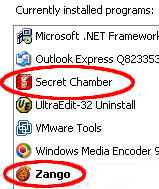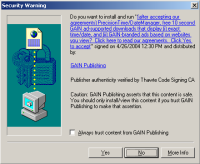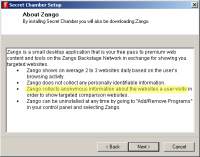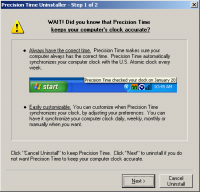Among the highlights of my winter holiday reading was a MediaPost interview of Reed Freeman, chief privacy officer of Claria. Freeman makes a series of claims about Claria’s practices — setting out high standards that he claims Claria already meets. As it turns out, his claims are in multiple instances verifiably false.
Removing Claria Programs – Neither “Intuitive” Nor “Standard”
Freeman claims that Claria has “the intuitive and standard Windows uninstall process.” I disagree.
Install Claria software in a bundle with Kazaa, and there will be no “Claria,” “Gator,” or “GAIN” listing in Control Panel’s Add/Remove Programs. Same for the other programs that bundle Gator (like DivX and Grokster). Instead, users who want to remove Gator are required to figure out that they need to select the “Kazaa” entry in Add/Remove Programs. That’s neither intuitive nor standard.
Claria admittedly sometimes tells users about its unusual removal procedure. Five pages (370+ words) into Claria’s license (as shown by Kazaa), Claria mentions “If you would like to stop receiving GAIN-branded advertisements, you will need to remove all GAIN-Supported Software on your computer using … Add/Remove Programs.”
 Screen-shot showing that when Zango comes with Secret Chamber, Zango receives a separate entry in Add/Remove Programs. Claria’s Gator, in contrast, lacks such an entry.
Screen-shot showing that when Zango comes with Secret Chamber, Zango receives a separate entry in Add/Remove Programs. Claria’s Gator, in contrast, lacks such an entry.
But Freeman doesn’t claim that Claria’s uninstall process is well-documented. He claims it’s “standard.” To the contrary, when other programs come in bundles, they generally include separate entries in Add/Remove Programs. For example, when RealPlayer comes with Google Toolbar, each program gets a separate Add/Remove listing. Even among so-called “adware” programs (that monitor users’ web browsing and show advertisements), Claria’s approach is unusual. When 180solutions Zango comes bundled with other programs (like Zango Games’ Secret Chamber), Zango has its own entry in Control Panel. See screen-shot at right.
Neither is Claria’s uninstall procedure “intuitive.” The intuitive way to remove an unwanted program is to find it, by name, in Add/Remove Programs. Claria makes the process harder by forcing users to figure out which programs bundled which — an unnecessary procedure that is not “intuitive.” The process becomes even more difficult when Claria cross-promotes its various products: Once a user receives Claria’s advertising-display software, Claria often shows pop-ups that encourage installation of other Claria programs, such as clock synchronizers and weather monitors. As a result, many Claria users run multiple “Gator-supported” applications, each of which must be separately identified and removed to complete Claria’s so-called “intuitive” uninstall.
Also nonstandard is Claria’s prohibition on using “unauthorized” removal methods (namely, removal tools like Ad-Aware and Spybot). See my earlier Gator’s EULA Gone Bad.
One-Step Install, Harder Uninstall
 A Claria drive-by installer, installing Claria software (without any further request for consent) if users press Yes.
A Claria drive-by installer, installing Claria software (without any further request for consent) if users press Yes.
Freeman later reports “The FTC has long taken the position that consumers should be able to get out of the bargain just as easily as they got into it.” Turning to Claria’s practices, he claims “you can get into our bargain by responding to an ad, and you can get out of our bargain by responding to an ad.”
Freeman makes it sound like removing Claria is as easy as getting Claria, but that’s just not the case. Claria software can become installed after only a single click on a single “Yes” button in a Claria “drive-by” ActiveX pop-up (like the one at right).
In contrast, removing Claria requires a longer procedure. At best, click Start – Settings – Control Panel – Add/Remove Programs, then find the installed Claria or third-party program, press Remove, and press Next twice (eight clicks total) . The final two clicks are necessary to decline Claria’s pleas to remain installed. (See the screen-shot at left.) Through this procedure, Claria requires triple confirmation before its software can be uninstalled, even though Claria had requested no extra confirmation to get onto users’ PCs.
So users can receive Claria by clicking once on a single ad, but removing Claria requires many more steps. This design seems like a clear violation of the “get out … as easy as … got in” rule Freeman attributes to the FTC. Why not place a one-click uninstall button on every Claria ad, so users can remove Claria as easily as they got it?
Telling Users What Claria Really Does
Freeman further notes the importance of disclosing what a program will do before that program is installed on a user’s PC. Freeman explains:
“The law is that material terms have to be disclosed prior to a consumer’s taking action. … Material terms, as defined by the FTC, are those that are likely to affect a consumer’s conduct with respect to a product or service. … In my view, the key terms that consumers should know–those that consumers would be unhappy if they didn’t know–are that we will track your online behavior and serve you advertising. Those key material terms are disclosed in every download process … in a way that is unavoidable prior to the consumer taking action “
I applaud Freeman’s emphasis on timely disclosures. But here too, Claria’s actual practices fall short.
Claria’s prominent disclosures say nothing of transmission or storage of users’ activities. The first page of Claria’s license (as shown by the Kazaa installer) mentions that advertisements are “selected in part based on how you surf the Web.” From this disclosure, users could reasonably conclude that Claria’s software chooses ads by mere monitoring of users’ activities — observing a user at one travel site, then showing a pop-up ad for another.
But as it turns out, Claria does more. Claria transmits users’ activities to its servers, then stores this information in a huge database. A November 2003 eWeek article reported that Claria’s then-12.1 terabyte database was already the seventh largest in the world — bigger than Federal Express, and rivalling Amazon and Kmart. A recent Oracle press release touted Claria as “one of the the world’s largest Oracle Data Warehouse … deployments.”
Claria’s license fails to prominently disclose transmission and storage of users’ activities. That advertisements are “selected in part based on how you surf the web” says nothing of any central Claria database recording who goes where. Only at page 11 of 63, 950 words into its 5,900+ word license, does Claria finally explain its true design — transmitting user activities to Claria servers — by admitting that “we do know … some of the web pages viewed” (emphasis added).
 Screen-shot showing the disclosure shown by Zango when bundled with Secret Chamber. Zango prominently discloses that it “collects” information about users’ web site visits.
Screen-shot showing the disclosure shown by Zango when bundled with Secret Chamber. Zango prominently discloses that it “collects” information about users’ web site visits.
Here again, Claria’s disclosure is inferior to its competitors. 180solutions software is sometimes installed without any notice or consent at all — for example, through security holes. (video) But when 180 requests permission to install, it offers a more forthright description of its intended activities. For example, when installed with the Secret Chamber video game, 180 prominently discloses: “Zango collects … information about the websites a user visits.” (screenshot)
A user who receives 180’s disclosure learns that 180 will not only monitor online behavior, but also collect this data. That’s a fact 180 seems to regard as relevant — worth bringing to users’ attention, beyond fine print midway through a long license agreement. It’s a fact of likely interest to many users — who may not want their data stored, perhaps permanently, on Claria’s servers. So this transmission and collection is, in Freeman’s words, a fact consumers “would be unhappy if they didn’t know.” By Freeman’s own standard, then, this fact ought to be more prominently presented in Claria’s disclosure — on page one, not page eleven.
